For 270 million years, dragonflies, with their four long independent membranous wings and long bodies, have remained unchanged in their essential form. They are far older than flowering plants. Almost all require permanent water for life. The greatest variety are found around large ponds and broad slow streams, with water clear and shallow enough for an abundance of vegetation - the sort of wetland that is most threatened with extinction near urban areas of Canada. So, your interest in them will aid conservation of our biodiversity.
Only three groups of insects have retained the original net-veined wing structure of early insect times. They can be easily distinguished by their wing shapes: the hindwings of dragonflies are broader than their forewings, the hind wings of damselflies are the same size as their forewings, while the hind wings of mayflies are much shorter than their forewings.
Identification of these insects by amateurs is complicated slightly by two factors. First, as with most insects, there are no commonly used English names for most species, so a bit of zoological Latin is necessary. (Many proposals of 'English' names have been made over the years, most recently by the Dragonfly Society of America, but none has achieved widespread usage.) Second, the primary separators of species in most of the order are the shapes of the reproductive organs. We can distinguish most of these only with close observation, usually with some magnification. However, on the positive side, the order Odonata, which includes damselflies and dragonflies, has been very well studied and characterized. It is possible to reliably separate almost all our local adults while in a net, and to release them unharmed after observation. Although most dragonflies spend several years as a nymph, and a month or less as an adult, odonates seem to differentiate among themselves as species only in the adult stage, so the treatment here is not wholly people-centered.
Some dragonflies fly so high and fast that they are very difficult to catch. (To net a flying dragonfly, by the way, always swing from directly behind them, where their eyesight is least effective.) It is easiest to study resting dragonflies without disturbing them, and that is what this guide is designed for. Approach them slowly, with as little side-to-side motion as possible. Dragonfly eyes don't focus - they will only note that you are getting closer because your image expands. If sideways motion is slow they often don't seem to see it. You will soon recognize the slight vibration of their wings that signals their imminent takeoff, and stop moving first. Many fly only a short distance, shorter each time they move if not unduly alarmed, and eventually allow a very close approach, as you can see from my photos. (Most were taken with a 55 mm lens.) Most dragonflies are less wary near the warmth of noon than in the chill of early morning, less likely to flee if males on territory, or newly emerged.
The Life Cycle of Damselfiles and Dragonflies
The breeding process in the Odonata begins when the male transfers sperm from his sperm duct on segment 9 to the underside of his segment 2. He then grabs a female by the top of her head (dragonflies) or by a specially-shaped plate on the top of the thorax (damselflies) with his rear appendages. If the shape of these male and female parts differs too much, he cannot hold on, but if he can, and his hold feels right to the female, she bends the end of her abdomen up to the male's 2nd abdominal segment. If this second pair of parts match up, mating takes place. Most species begin this in flight with the female flying upside down, but many then land on any handy surface to complete the process.
In some species, the shape of the male's hamuli on the second segment are designed to scour out the sperm of any male with whom the female has previously mated. In others, the male continues to hold on to the female until she lays her eggs. In others, the male is exceptionally vigilent to guard the female from other males until she has laid her eggs.
Some species drop them into water, others saw a slit in aquatic vegetation and insert eggs individually. An egg may hatch fairly quickly and the insect overwinter as a nymph, or overwinter and hatch in spring. Nymphs live almost entirely in water, and eat any aquatic creatures they can catch, including their own kind. Some actively stalk their prey, others hide in bottom litter and wait for it to come to them. All are camouflaged mud colour. After a number of moults, extending as long as 5 years in a few species, the nymph crawls out of the water, almost always up an aquatic plant such as a rush. Its skin splits open along its back, and the young adult emerges. After a few days in hiding while it's wings and skeleton harden, it begins it's search for food, territory and a mate, to continue the cycle of life.
Of course, a few things may interrupt this cycle! Fish, amphibians, and many aquatic insects eat the eggs and nymphs. A number of parasites are adapted to dragonflies. One of these looks like small scarlet coloured spheres on adult odonates. This is the immature stage of water mites of the family Hydracarina. Emerging adults are caught by birds. A few dragonflies specialize in eating other dragonflies. Perhaps the most spectacular predators of adult dragonflies are vespid wasps. These fly head on at a flying dragonfly, engage each of their 6 legs to a dragonfly leg front to back and, while holding their abdomen out of reach of the dragonfly's frantically snapping jaws, bend up and bite the dragonfly's wings off one by one, to float away in the air. The wasp then flies off with the dragonfly to a burrow, paralyses it with a sting, and lays an egg on it. The wasp larva lives off the dragonfly until it pupates. It took over a minute for the wasp to subdue the dragonfly both times I have observed it, and the buzzing of all those wings could be heard a hundred metres away.
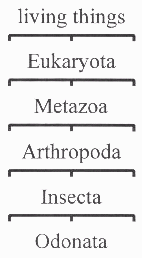 Identification of Dragonflies
Identification of Dragonflies
Among living things, we classify those made up of cells containing partly autonomous membrane-bounded sub-cells (organelles) as the superkingdom Eukaryota. Eukaryotes with mitochondrial organelles and an extracellular matrix of collagen are placed in the kingdom Metazoa, animals. Animals with a segmented body and hardened body wall (exoskeleton) comprise the phylum Arthropoda. Arthropods with three pairs of legs and three body regions comprise the class Insecta, insects. Insects with transparent many-veined wings held at rest at right angles to the body, horizontally to the side or vertically over the back (not like a roof as with most insects), are the order Odonata, and are the subject of this guide.
The veins in an insect wing stiffen it so that it bends appropriately under stress to produce aerodynamic lift in the optimal way for long term survival of the species. The stigma of dragonflies is a relatively heavy part of the wing - it's inertia is important in regulating the twist of the wing. There are a great many possible optimal vein arrangements given the performance criteria, so a great deal of wing venation is arbitrary in detail, but strongly selected within a breeding population, particularly during defense of territory. It is therefore properly trusted as a guide to the evolutionary relationships between many insects. Venation is also easy to see clearly, both on a living insect in a net and in a century-old museum specimen. (Unless freeze-dried or preserved with acetone, dragonfly bodies lose their colour when dead.) So, all keys, including this one, use wing venation whenever possible to separate species - it's worth learning. The venation system used here is that of Comstock, because I find it the clearest. There is another system developed by Tillyard that you will also find in the specialist literature.
When dragonflies emerge from the nymph, they often have quite different colours than those they develop after a week or so. Also, many males develop 'prunescence', a coating of light grey to blue that thickens with age and can obscure otherwise-useful field marks. The colours in most published keys are those of mature specimens; my field-mark sections provide for all changes with age that I have observed.
It appears that the success of dragonfly mating is determined mostly by the shapes of the sex parts, so that they are in fact the true separators of species. However, use of them requires separate keys for male and female throughout. And, some parts, particularly the thorax plates of female damselflies, are too small to be easily differentiated with even a hand magnifier on a live insect. The following key elements are those I find most useful for living insects in the field, as opposed to the details most reliable in a museum context. I am replacing the key format by conventional field marks as I gain sufficient experience to be certain that they are sound throughout the District.
Since this guide is designed for non-specialists, I use English terms rather than the specialists' Latin whenever possible, and use drawings to illustrate most details. Sub species are omitted. It applies to the species expected to occur within the Ottawa District, and must be used with caution elsewhere. The terms preceding the semicolon are the key proper, and should all apply to a specimen from this area; terms following the semicolon are additional information chosen to confirm the choice. Within each numbered section, key descriptions are to be examined in order - later descriptions assume that species satisfying prior descriptions are no longer being considered. Field-marks, however, are each unique within the genus and may be checked in any order. The main diagrams are labelled with the terms used throughout.
I have found reliable records of 114 species of dragonfly within the Ottawa District - a further 9 species are known close to the District and might be found here. Dates include the earliest and latest recorded sightings for flying adults of each species in Ontario. These dates were mostly accumulated in central Ontario; it appears that in Ottawa dragonflies regularly are active well outside these periods - as much as 3 weeks earlier in the spring and 6 weeks later in the fall. I would appreciate notes of such records so that the dates here will be as representative as possible for the Ottawa District.
I use the nomenclature of R.W.Garrison, 'A Synonymic List of the New World Odonata', Argia 3(2):1-30 (1991). My primary technical reference is E.M Walker, 'The Odonata of Canada and Alaska', which should be consulted (with Garrison in hand) for further information. I also recommend J.G.Needham & M.J.Westfall, 'A Manual of the Dragonflies of North America' and A.Robert, 'Les libellules du Québec'.
I thank Raymond Hutchinson for extensive assistance throughout this project, and for permission to use the drawings prepared for 'Manuel d'identification des Libellules du Québec'. Agriculture and Agri-Food Canada granted access to their technical libraries and the Canadian National Collection of Insects. I welcome reports of corrections and additions to this list, and of any suggestions to make the field identification of these beautiful insects easier and more reliable.
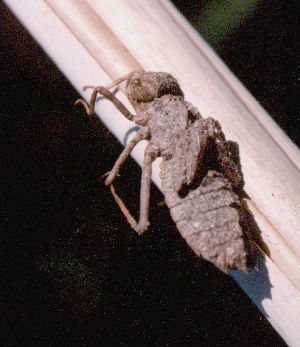
the shell of a nymph still clings to a reed after the adult emerges
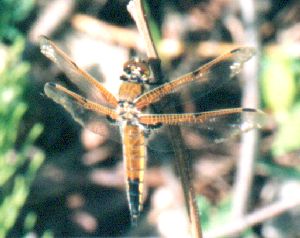
this Libellula quadrimaculata's wings have not yet fully expanded
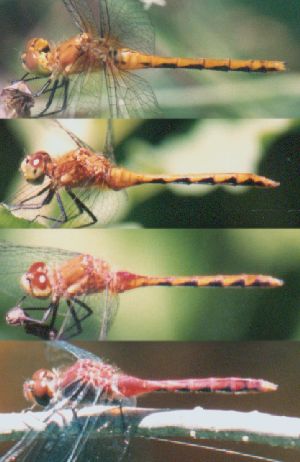
colour change in Sympetrum obtrusum with age, from newly-emerged yellow at top to
mature red at bottom
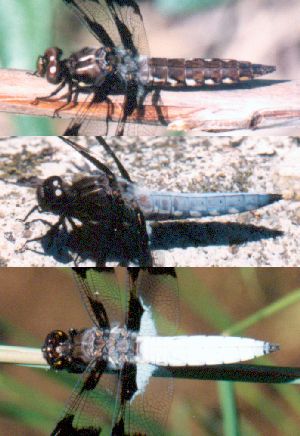
prunescence change in male Libellula lydia with age, newly-emerged at top, mature at
bottom
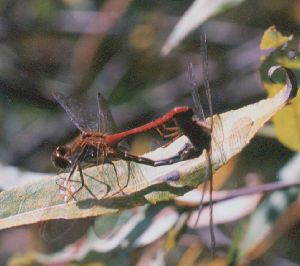
Sympetrum rubicundulum mating
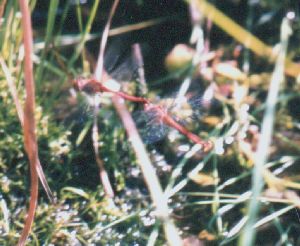
Sympetrum rubicundulum laying eggs